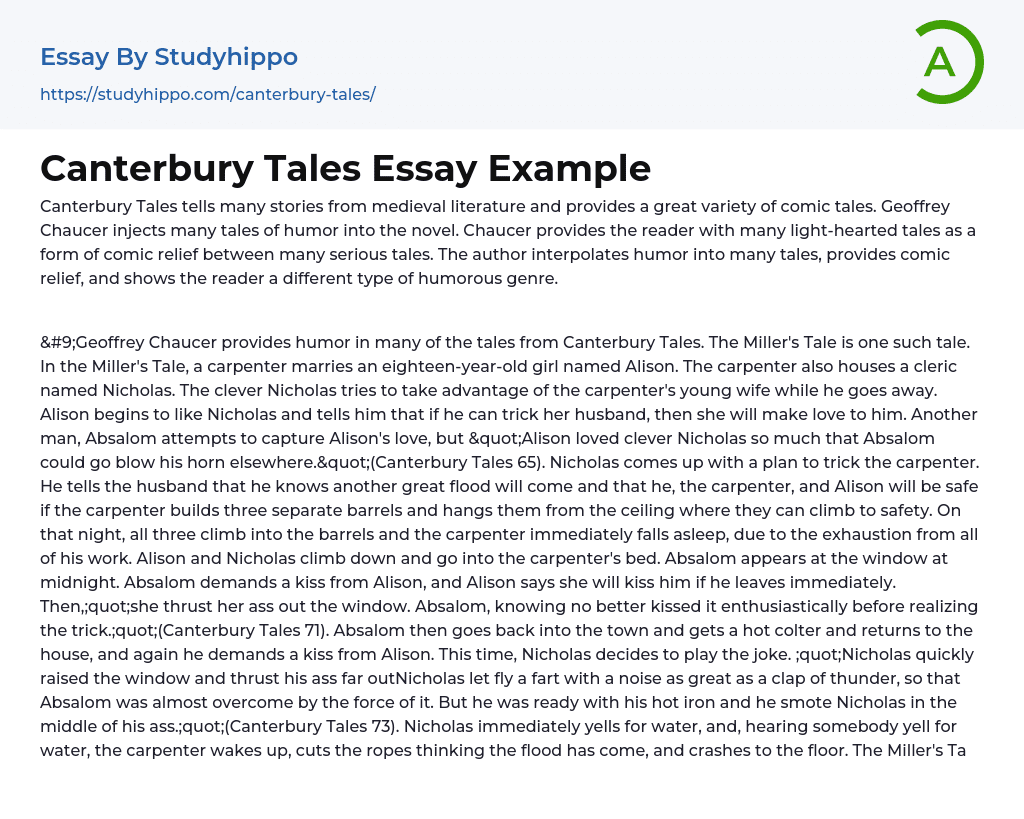Canterbury Tales presents a wide range of comedic tales from medieval literature, injecting humor into the novel. Geoffrey Chaucer incorporates numerous lighthearted stories to provide comic relief amidst the serious ones. The author cleverly infuses humor into various tales, offering the reader a refreshing and unique genre of comedy.
In Canterbury Tales, Geoffrey Chaucer showcases humor through various tales, including the Miller's Tale. The Miller's Tale revolves around a carpenter named Alison who marries a young girl named Alison. In their household resides a cleric named Nicholas who is cunning and attempts to seduce the carpenter's wife while he is away. Alison starts to develop feelings for Nicholas and proposes that if he can deceive her husband, she will engage in a romantic relationship with him. Another man named Absalom also tries to win Alison's love
..., but she favors Nicholas and dismisses Absalom's advances. To execute his plan, Nicholas devises a scheme where he informs the carpenter that a great flood is imminent and they need to be prepared for it. He persuades the carpenter to construct three separate barrels suspended from the ceiling, which they can use to escape. That night, all three individuals climb into the barrels, and due to exhaustion, the carpenter falls asleep immediately. Seizing the opportunity, Alison and Nicholas descend from the barrels and secretly enter the carpenter's bed. At midnight, Absalom appears at the window demanding a kiss from Alison. She promises to fulfill his request if he leaves immediately. Mischievously, Alison exposes her rear through the window, prompting Absalom to enthusiastically kiss it before realizing he has been tricked (Canterbury Tales 65, 71).Absalom goes back to the town
grabs a hot iron, and returns to the house, demanding another kiss from Alison. This time, Nicholas decides to play a prank. He opens the window and sticks his butt out, letting out a loud fart that surprises Absalom. However, Absalom quickly strikes Nicholas with the hot iron on his butt. Nicholas screams for water, waking up the carpenter who mistakes it for a flood and cuts the ropes, causing him to fall to the floor. This part of "The Miller's Tale" exemplifies Chaucer's humor. He injects numerous humorous events into the story, connecting them in a humorous and ironic manner. The tale concludes with the foolish husband being taken advantage of, adding to the comedic aspect of Chaucer's stories.
Chaucer also uses humor in his tales to provide comic relief. These humorous tales serve as a way to alleviate the seriousness present in other stories. Stories like "The Miller's Tale" and "The Reeve's Tale" balance out the gravity found in tales like "The Second Nun's Tale" and "The Pardoner's Tale." Many of the tales in Canterbury Tales depict themes of hypocrisy, greed, and inadequate faith.Chaucer's tales aim to impart moral lessons on man's religious obligations. The Miller's Tale and the Reeve's Tale, for instance, serve as lighthearted lessons on marriage, love, and trust. Chaucer uses these humorous tales to deliver insights on life. Employing a jovial approach, Chaucer demonstrates the foolishness of certain characters, ultimately conveying a message to the reader. By using humor, the author effectively conveys messages in a lighthearted manner, providing comic relief to counterbalance the more serious tales and approaches.
	Geoffrey Chaucer incorporates the genre of humor known as fabliau,
which contributes to the essence of his work. The Miller's Tale, Reeve's Tale, Shipman's Tale, and Summoner's Tale in Chaucer's Canterbury Tales exemplify the use of fabliaux. Fabliaux are brief comic tales that are often insulting and obscene. Typically set in the present and depicting familiar situations, they vividly portray occurrences in everyday life. Prior to Chaucer, fabliaux were only found in French literature. These tales typically satirize greed, hypocrisy, pride, as well as target old age, ignorance, and husbands' attempts to protect their wives' chastity. The protagonists, usually young and clever, are often marginalized by society. Within the Canterbury Tales, some characters may appear as lecherous priests, shrewd citizens, or unfaithful wives. The victims are usually respected members of society such as prosperous individuals, hard-workers, and women striving for chastity. By using this lighthearted genre, Chaucer infuses humor into his novel. He effectively employs the fabliau genre to create an atmosphere of jovial buffoonery in the Canterbury Tales.
;#9;Canterbury Tales offers numerous lessons and morals, along with a range of comic tales. Chaucer includes various humorous stories in Canterbury Tales, which serve to highlight important lessons, offer comedic relief, and showcase an uncommon form of humor.
- Book Summary essays
- Metaphor essays
- Reader essays
- Rhyme essays
- Literary devices essays
- Villain essays
- Books essays
- Genre essays
- Literary Criticism essays
- Writer essays
- Protagonist essays
- Simile essays
- Poem essays
- Book Report essays
- Book Review essays
- Greek Mythology essays
- Plot essays
- Tragic Hero essays
- Coming of Age essays
- Play essays
- Rhetoric essays
- Rhetorical Question essays
- Translation essays
- Understanding essays
- Reason essays
- Character essays
- Letter essays
- American Literature essays
- Literature Review essays
- Utopia essays
- Poetry Analysis essays
- Dante's Inferno essays
- Between The World and Me essays
- Incidents in The Life of a Slave Girl essays
- Flowers for Algernon essays
- Myth essays
- Everyday Use essays
- Boo Radley essays
- Genesis essays
- Richard iii essays
- Alice in Wonderland essays
- On the road essays
- Ozymandias essays
- The Nightingale essays
- Holden Caulfield essays
- Animal Farm essays
- 1984 essays
- A Hanging essays
- Shooting An Elephant essays
- A Tale Of Two Cities essays




